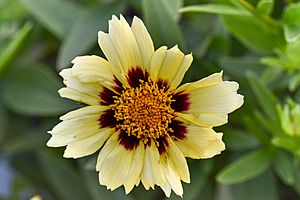Plains coreopsis facts for kids
Quick facts for kids Plains coreopsisCoreopsis tinctoria |
|
|---|---|
 |
|
| Scientific classification | |
| Genus: |
Coreopsis
|
| Species: |
tinctoria
|
| Synonyms | |
|
Synonymy
Bidens tinctoria (Nutt.) Baill.
Calliopsis atkinsoniana (Douglas ex Lindl.) Hook. Calliopsis bicolor Rchb. Calliopsis cardaminefolia DC. Calliopsis tinctoria (Nutt.) DC. Coreopsis atkinsoniana Douglas ex Lindl. Coreopsis bicolor (Rchb.) Bosse ex Buchenau Coreopsis cardaminefolia (DC.) Torr. & A.Gray Coreopsis gracilis Blanco Coreopsis similis F.E.Boynton Coreopsis stenophylla F.E.Boynton Diplosastera tinctoria (Nutt.) Tausch |
|
Plains coreopsis, also known as garden tickseed or golden tickseed, is a beautiful annual flower. This means it grows from seed, flowers, produces seeds, and then dies all within one year. Its scientific name is Coreopsis tinctoria.
You can find this plant across many places. It grows naturally in Canada, from Quebec to British Columbia. It is also common in parts of northeast Mexico and much of the United States. In the Great Plains and Southern states, people often call it "calliopsis." This plant is also grown and found in the wild in China. Plains coreopsis often grows in places where the ground has been disturbed, like along roadsides or in farm fields.
Contents
What Plains Coreopsis Looks Like

Plains coreopsis plants grow quite quickly. They can reach heights of 12 to 40 inches (30–100 cm), which is about as tall as your waist or chest. Their leaves are divided into many small parts, like a feather. These leaves are smooth and become thinner towards the top of the plant.
At the top, you'll see many bright flower heads. These flowers are usually 1 to 1.5 inches (2.5 to 4 cm) wide. They sit on thin stems. The flowers are a brilliant yellow color. In the center, they have maroon or brown parts called disc florets. Plains coreopsis usually blooms in the middle of summer. Its small, thin seeds sprout in the fall or early spring. Young plants often spend the winter as a small cluster of leaves close to the ground.
Traditional Uses of Plains Coreopsis
The Zuni people, a Native American tribe, have traditionally used the blossoms of the tinctoria variety. They used them to make a rich mahogany red dye. This dye was perfect for coloring yarn. They also used the flowers to make a warm drink. This was a popular beverage before coffee became common. The Zuni people also used parts of the plant in traditional remedies.
Growing Plains Coreopsis in Gardens
Plains coreopsis is a popular plant for gardens. People grow it as an ornamental plant because its flowers are so pretty. It is also used in wildlife gardens and for natural landscaping. This helps support local wildlife.
This plant can grow well in many different types of soil. However, it seems to prefer sandy soil or soil that drains water easily. Even though it can handle some dry weather, you usually find it growing where there is regular rainfall. Plains coreopsis loves full sun, but it can also grow in places with some shade.
Popular Types of Plains Coreopsis
Plains coreopsis is easy to grow. Its bright, showy flowers make it a favorite for making landscapes beautiful. It is also popular in flower gardens. There are special types of this plant called cultivars. One example is 'Roulette'. This type has golden stripes on a deep mahogany background, making its flowers look like tiger stripes.


